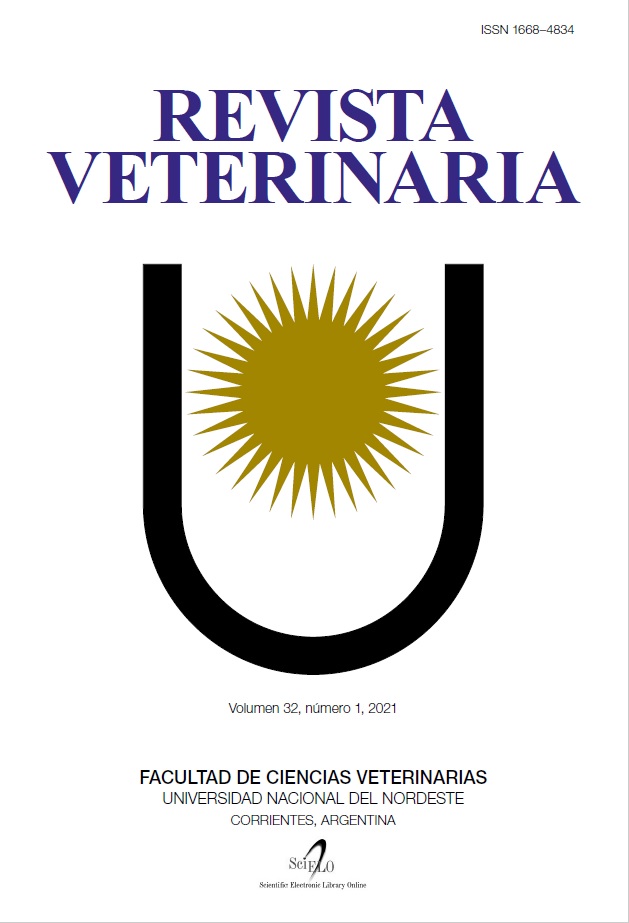Mortality of equines for Trypanosoma evansi in Argentina. Parasitological and molecular diagnostic
DOI:
https://doi.org/10.30972/vet.3215648Keywords:
Trypanosoma evansi, equines, outbreak, Corrientes (Argentina)Abstract
Trypanosoma evansi is the causative agent of trypanosomosis and affects a wide variety of domestic and wild animals, with horses being the main affected. The objective of this work is to describe an outbreak of trypanosomosis due to T. evansi in twenty (20) horses with symptoms characterized by progressive weight loss, loss of appetite, intermittent hyperthermia, weakness, lymphoadenomegaly, pale mucous membranes, nasal secretions and epiphora, edemas in the chest area, abdomen and later members. The diagnosis was positive for T. evansi. The treatment consisted of diminacin aceturate without satisfactory results. This work is the first report of death of horses by T. evansi with parasitological and molecular diagnosis in the town of Monte Caseros, Corrientes, Argentina.Downloads
References
Brun R, Hecker H, Lun ZR. 1998. Trypanosoma evansi and T. equiperdum: Distribution, biology, treatment and phylogenetic relationship (a review). Vet Parasitol 79: 95-107.
Chagas CR, Binkienė R, Ilgūnas M, Iezhova T, Valkiūnas G. 2020. The buffy coat method: A tool for detection of blood parasites without staining procedures. Parasites & Vectors v.13.
Fereig RM et al. 2017. Seroprevalence of Babesia bovis, B. bigemina, Trypanosoma evansi and Anaplasma marginale antibodies of cattle in southern Egypt. Ticks Tick Borne Dis 8: 125-131.
Gillingwater K et al. 2010. In vitro activity and preliminary toxicity of various diamidine compounds against Trypanosoma evansi. Vet Parasitol 169: 264-272.
Monzón CM, Hoyos CB, Jara GA. 1995. Brotes de tripanosoma equina causados por T. evansi en Formosa, Argentina. Rev Sci Tech OIE 14: 747-752.
Paoletta MS et al. 2018. Epidemiology of Babesia, Anaplasma and Trypanosoma species using a new expanded reverse line blot hybridization assay. Ticks Tick Borne Dis 9: 155-163.
Parodi P et al. 2018. Diagnóstico parasitológico y molecular de tripanosomiasis canina por Trypanosoma evansi en perros asociados a la caza, en dos localidades del Departamento de Artigas, Uruguay. Vet 54.
Peregrine AS. 1994. Chemotherapy and delivery systems:
haemoparasites. Vet Parasitol 54: 223-248.
Sudarto MW, Tabel H, Haines DM. 1990. Immunohistochemical demonstration of Trypanosoma evansi in tissues of experimentally infected rats and a naturally infected water buffalo (Bubalus bubalis). J Parasitol 76: 162-167.
Sumba AL, Mihok S, Oyieke FA. 1998. Mechanical transmission of Trypanosoma evansi and T. congolense by Stomoxys nigerand S. taeniatusin a laboratory mouse model. Med Vet Entom 12: 417-422.
Wilkowsky SE. 2018. Trypanosoma. In: Parasitic protozoa of farm animals and pets. Springer International Publishing 2018: 271-287.
Downloads
Published
How to Cite
Issue
Section
License
Revista Veterinaria (Rev. Vet.) maintains a commitment to the policies of Open Access to scientific information, as it considers that both scientific publications as well as research investigations funded by public resources should circulate freely without restrictions. Revista Veterinaria (Rev. Vet.) ratifies the Open Access model in which scientific publications are made freely available at no cost online.











.jpg)
.jpg)



